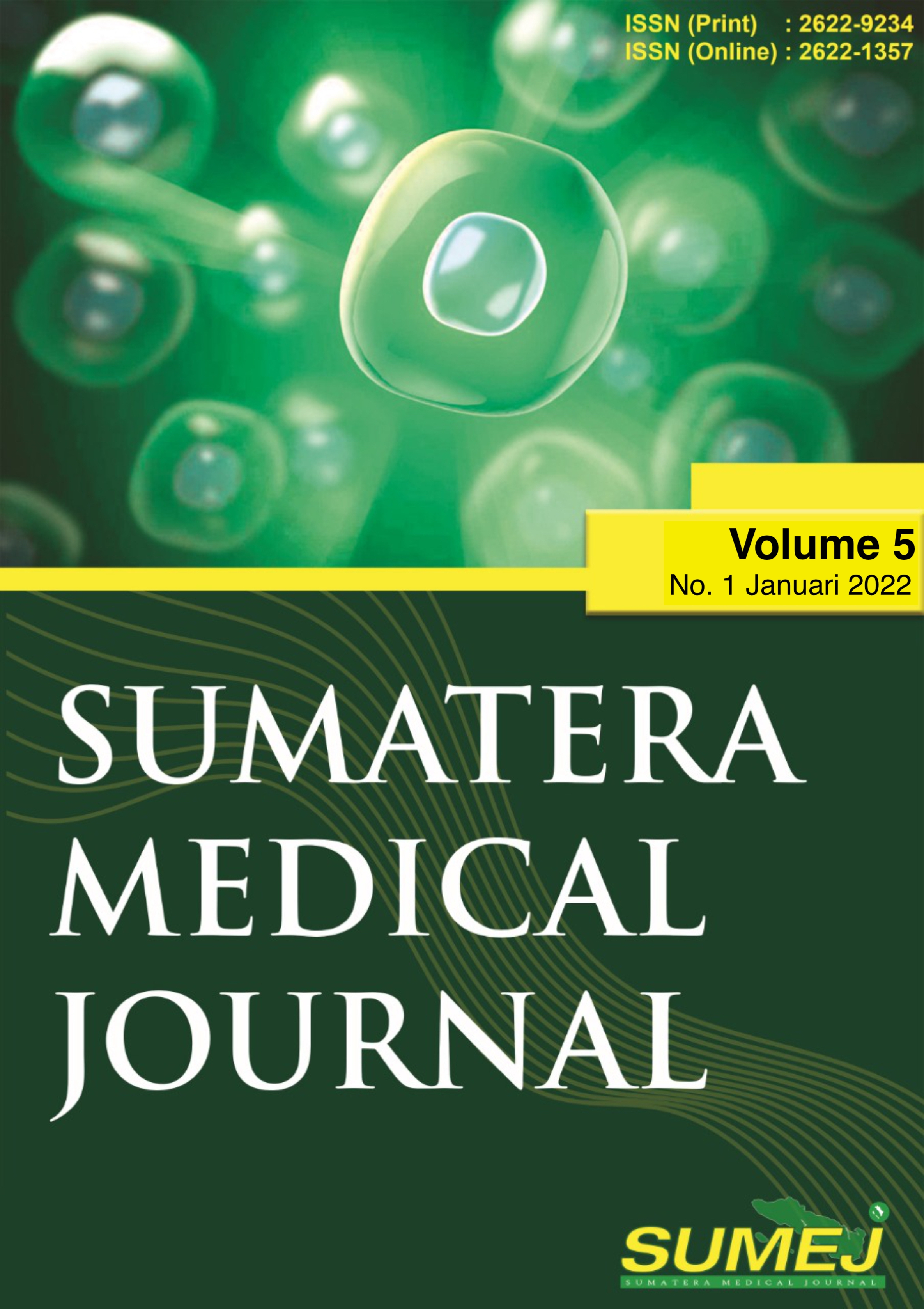Association of Glycosyllated Hemoglobin (Hba1c) Levels to the Severity of Diabetic Foot Ulcer in Type 2 Diabetes Mellitus Patients in RSUP. H. Adam Malik Medan
DOI:
https://doi.org/10.32734/sumej.v5i1.9060Keywords:
HbA1c, Diabetic foot, Diabetes mellitus, Degree of ulcersAbstract
Abstrak
Introduction: Diabetic ulcers with neuropathy require amputation or time to fully heal. The worse blood sugar control, it will worsen the condition of complications such as diabetic ulcers, diabetic neuropathy, and other complications. Wound healing in diabetic ulcers is influenced by controlled HbA1c levels.
Methods: This study is an observational analytic study with a retrospective design used in this study with secondary data. This study is analytical because it aims to obtain the correlation of HbA1c with the severity of diabetic ulcers in patients with diabetes mellitus at H. Adam Malik Hospital.
Results: The average age of the patients was 62 with the majority of respondents being male. The dominance of respondents came with Grade IV as many as 17 people, with uncontrolled HbA1c levels as many as 39 people. Using Spearman Corelation test, the value of r = 0.735, 0.736, and 0.785, respecttively for the corelation between HbA1c, Hb and ESR levels with the severity of diabetic foot ulcers ,with a value (p = 0.0001).
Conclusion: We found a strong correlation and a significant relationship between HbA1c, Hb, and ESR levels with the severity of diabetic foot ulcers.
Downloads
References
Aamir AH, Nasir A, Jadoon MZ, Mehmood K, Ali SS: Diabetic foot infections and their management in a tertiary care hospital. J Ayub Med Coll Abottabad. 2011, 23:58-62.
Abolfotouh MA, Alfaifi SA, Al-Gannas AS. Risk factors of diabetic foot in central Saudi Arabia. Saudi Med J 2011;32:708-13.
AlGoblan, A. et al., 2016. Prediction of diabetic foot ulcer healing in type 2 diabetic subjects using routine clinical and laboratory parameters. Research and Reports in Endocrine Disorders, p.11.
Al-Rubeaan K, Al Derwish M, Ouizi S, Youssef AM, Subhani SN, Ibrahim HM, et al. Diabetic foot complications and their risk factors from a large retrospective cohort study. PLoS One 2015;10:e0124446.
Assaad-Khalil SH, Zaki A, Abdel Rehim A, Megallaa MH, Gaber N, Gamal H, et al. Prevalence of diabetic foot disorders and related risk factors among egyptian subjects with diabetes. Prim Care Diabetes 2015;9:297-303.
Casadei G, Filippini M, Brognara L. Glycated Hemoglobin (HbA1c) as a Biomarker for Diabetic Foot Peripheral Neuropathy. Diseases. 2021;9(1):16. Published 2021 Feb 22.
Cheng, P., Neugaard, B., Foulis, P., & Conlin, P. R. (2011). Hemoglobin A1C as a predictor of incident diabetes. Diabetes Care, 34(3), 610–615. https://doi.org/10.2337/dc10-0625
Chuan, F. et al., 2016. Anemia in patients with diabetic foot ulcer. The International Journal of Lower Extremity Wounds, 15(3), pp.220–226.
Christman, A.L. et al., 2011. Hemoglobin A1C predicts healing rate in diabetic wounds. Journal of Investigative Dermatology, 131(10), pp.2121–2127.
Cowie CC, Rust KF, Ford ES, et al. 2009: Full accounting of diabetes and pre- diabetes in the U.S. population in 1988–1994 and 2005–2006. Diabetes Care. 32:287–94. [PubMed: 19017771]
Christman AL, Selvin E, Margolis DJ, Lazarus GS, Garza LA. Hemoglobin A1c predicts healing rate in diabetic wounds. J Invest Dermatol 2011;131:2121- 7.
Deribe B, Woldemichael K, Nemera G. Prevalence and factors influencing diabetic foot ulcer among diabetic patients attending Arbaminch Hospital, South Ethiopia. Journal of Diabetes and Metabolism.2014;2:322. Dinh T, Veves A. The influence of gender as a risk factor in diabetic foot ulceration. Wounds. 2008 May;20(5):127-31. PMID: 25942414
Elsharawy MA, Hassan K, Alawad N, Kredees A, Almulhim A. Screening of diabetic foot in surgical inpatients: A hospitalbased study in Saudi Arabia. Int J Angiol Off Publ Int Coll Angiol 2012;21:213-6.
Farooque U, Lohano A, Hussain Rind S, et al. (July 15, 2020) Correlation of Hemoglobin A1c With Wagner Classification in Patients With Diabetic Foot. Cureus 12(7): e9199.
Pierpont YN, Dinh TP, Emerick Salas R, et al. Obesity and surgical wound healing: a current review. International Scholarly Research Notices Obesity. 2014;2014:13.
Shahbazian H, Yazdanpanah L, Latifi SM. Risk assessment of patients with diabetes for foot ulcers according to risk classification consensus of International Working Group on Diabetic Foot (IWGDF). Pak J Med Sci 2013;29:730-4.
Shah P, Inturi R, Anne D, Jadhav D, Viswambharan V, Khadilkar R, Dnyanmote A, Shahi S. Wagner's Classification as a Tool for Treating Diabetic Foot Ulcers: Our Observations at a Suburban Teaching Hospital. Cureus. 2022 Jan 22;14(1):e21501. doi: 10.7759/cureus.21501. PMID: 35223277; PMCID: PMC8861474.
Shatnawi, N.J. et al., 2018. Predictors of major lower limb amputation in type 2 diabetic patients referred for hospital care with diabetic foot syndrome. Diabetes, Metabolic Syndrome and Obesity: Targets and Therapy, Volume 11, pp.313–319.
Xiang, J., Wang, S., He, Y. et al. Reasonable Glycemic Control Would Help Wound Healing During the Treatment of Diabetic Foot Ulcers. Diabetes Ther 10, 95–105 (2019)
Yammine, K., Hayek, F. & Assi, C., 2021. Is there an association between anemia and diabetic foot ulcers? A systematic review and metaâ€analysis. Wound Repair and Regeneration, 29(3), pp.432–442.
Zubair M, Malik A, Ahmad J. Glycosylated hemoglobin in diabetic foot and its correlation with clinical variables in a north Indian tertiary care hospital. JDiabetes Metab 2015;6:7.
Downloads
Published
How to Cite
Issue
Section
License
Copyright (c) 2022 Sumatera Medical Journal

This work is licensed under a Creative Commons Attribution-NonCommercial-NoDerivatives 4.0 International License.
The Authors submitting a manuscript do so on the understanding that if accepted for publication, copyright of the article shall be assigned to Sumatera Medical Journal (SUMEJ) and Faculty of Medicine as well as TALENTA Publisher Universitas Sumatera Utara as publisher of the journal.
Copyright encompasses exclusive rights to reproduce and deliver the article in all form and media. The reproduction of any part of this journal, its storage in databases and its transmission by any form or media, will be allowed only with a written permission from Sumatera Medical Journal (SUMEJ).
The Copyright Transfer Form can be downloaded here.
The copyright form should be signed originally and sent to the Editorial Office in the form of original mail or scanned document.











